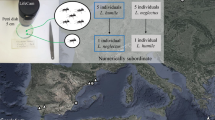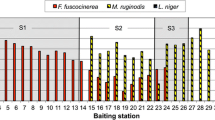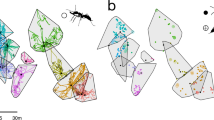Abstract
Argentine ants (Linepithema humile) usually actively displace native ants through a combination of rapid recruitment, high numerical dominance and intense aggressive fights. However, in some cases, native ants can offer a strong resistance. In Corsica, a French Mediterranean island, local resistance by the dominant Tapinoma nigerrimum has been proposed as a factor limiting Argentine ant invasion. With the aim of evaluating the abilities of T. nigerrimum in interference and exploitative competition, this study tested in the laboratory the aggressive interactions between this native dominant ant and the invasive Argentine ant. We used four different assays between L. humile and T. nigerrimum: (1) worker dyadic interactions, (2) symmetrical group interactions, (3) intruder introductions into an established resident colony, and (4) a competition for space and food. This study confirms the ability of Argentine ants to compete with native species, by initiating more fights, using cooperation and simultaneously deploying physical and chemical defenses. However, despite Argentine ant fighting capabilities, T. nigerrimum was more efficient in both interference and exploitative competition. Its superiority was obvious in the space and food competition assays, where T. nigerrimum dominated food in 100% of the replicates after 1 h and invaded Argentine ant nests while the reverse was never observed. The death feigning behavior exhibited by Argentine ant workers also suggests the native ant’s superiority. Our study thus demonstrates that T. nigerrimum can offer strong competition and so may be able to limit the spread of Argentine ants in Corsica. This confirms that interspecific competition from ecologically dominant native species can affect the invasion success of invaders, notably by decreasing the likelihood of incipient colony establishment and survival.


Similar content being viewed by others
References
Bernard F (1983) Les fourmis et leur milieu en France Méditerranéenne. Editions Lechevalier, S.A.R.L., Paris
Blight O, Orgeas J, Renucci M, Tirard A, Provost E (2009) Where and how the Argentine ant (Linepithema humile) spreads in Corsica? CR Biol 332:747–751
Blight O, Renucci M, Tirard A, Orgeas J, Provost E (2010) A new colony structure of the invasive Argentine ant (Linepithema humile) in Southern Europe. Biol Inv (in press) doi:10.1007/s10530-009-9561-x
Buczkowski G, Bennett GW (2008) Aggressive interactions between the introduced Argentine ant, Linepithema humile and the native odorous house ant, Tapinoma sessile. Biol Inv 10:1001–1011
Carney SE, Byerley MB, Holway DA (2003) Invasive Argentine ants (Linepithema humile) do not replace native ants as seed dispersers of Dendromecon rigida (Papaveraceae) in California, USA. Oecologia 135:576–582
Carpintero S, Reyes-Lopez J (2008) The role of competitive dominance in the invasive ability of the Argentine ant (Linepithema humile). Biol Inv 10:25–35
Carpintero S, Retana J, Cerda X, Reyes-Lopez J, Arias de Reyna L (2007) Exploitative strategies of the invasive Argentine ant (Linepithema humile) and native ant species in a Southern Spanish pine forest. Com Ecos Ecol 36:1100–1111
Casevitz-Weulersse J, Brun P (1999) Présence en Corse de la fourmi d’Argentine, Linepithema humile (Mayr) (Formicidae Dolichoderinae). BSSHNC 686–687:151–162
Cassill DL, Vo K, Becker B (2008) Young fire ant workers feign death and survive aggressive neighbors. Naturwissenschaften 95:617–624
Christian CE (2001) Consequences of a biological invasion reveal the importance of mutualism for plant communities. Nature 413:635–639
Cole FR, Medeiros AC, Loope LL, Zuehlke WW (1992) Effects of the Argentine ant on arthropod fauna of Hawaiian high-elevation shrubland. Ecology 73:1313–1322
Fellers JH (1987) Interference and exploitation in a guild of woodland ants. Ecology 69:1466–1478
Giraud T, Pedersen JS, Keller L (2002) Evolution of supercolonies: the Argentine ants of Southern Europe. Proc Nat Acad Sci 99(9):6075–6079
Gomez C, Espadaler X (1998) Seed dispersal curve of a Mediterranean myrmecochore: influence of ant size and the distance to nests. Ecol Res 13:347–354
Gomez K, Espadaler X (2006) Exotic ants (Hymenoptera: Formicidae) in the Balearic Islands. Myrmecol News 8:225–233
Gomez C, Oliveras J (2003) Can the Argentine ant (Linepithema humile, Mayr) replace native ants in myrmecochory? Acta Oecol 24:47–53
Hee JJ, Holway DA, Suarez AV, Case TJ (2000) Role of propagule size in the success of incipient colonies of the invasive Argentine ant. Conserv Biol 14:559–563
Hölldobler W (1990) The ants. Harvard University Press, Cambridge
Holway DA (1998) Factors governing rate of invasion: a natural experiment using Argentine ants. Oecologia 115:206–212
Holway DA (1999) Competitive mechanisms underlying the displacement of native ants by the invasive Argentine ant. Ecology 80:238–251
Holway DA, Case TJ (2001) Effects of colony-level variation on competitive ability in the invasive Argentine ant. Anim Behav 61:1181–1192
Holway DA, Lach L, Suarez AV, Tsutsui ND, Case TJ (2002a) The causes and consequences of ant invasions. Annu Rev Ecol Syst 33:181–233
Holway DA, Suarez AV, Case TJ (2002b) The role of abiotic factors in governing susceptibility to invasion: a test with a widespread invasive social insect. Ecology 83:1610–1619
Human KG, Gordon DM (1996) Exploitation and interference competition between the invasive Argentine ant, Linepithema humile, and native ant species. Oecologia 105:405–412
Human KG, Gordon DM (1997) Effects of Argentine ants on invertebrate biodiversity in northern California. Conserv Biol 11:1242–1248
Human KG, Gordon DM (1999) Behavioral interactions of the invasive Argentine ant with native ant species. Ins Soc 46:159–163
Kolar CS, Lodge DM (2001) Progress in invasion biology: predicting invaders. Trends Ecol Evol 16(4):199–204
Lockwood JL, Cassey P, Blackburn T (2005) The role of propagule pressure in explaining species invasions. Trends Ecol Evol 20:223–228
Mack RN, Simberloff D, Londsale WM, Evans H, Clout M, Bazzaz FA (2002) Biotic invasions: causes epidemiology, global consequences, and control. Ecol Appl 10:689–788
Marlier JF, Quinet Y, de Biseau JC (2004) Defensive behaviour and biological activities of the abdominal secretion in the ant Crematogaster scutellaris (Hymenoptera: Myrmicinae). Behav Process 67:427–440
Nowbahari E, Fénéron R, Malberbe M (1999) Effect of body size on aggression in the ant, Cataglyphis niger (Hymenoptera: Formicidae). Aggress Behav 25:369–379
Passera L (1994) Characteristics of tramp species. In: Williams DF (ed) Exotic ants: biology, impact, and control of introduced species. Westview Press, Boulder, pp 23–43
Rowles AD, O’Dowd DJ (2007) Interference competition by Argentine ants displaces native ants: implications for biotic resistance to invasion. Biol Inv 9:73–85
Sagata K, Lester PJ (2009) Behavioural plasticity associated with propagule size, resources, and the invasion success of the Argentine ant Linepithema humile. J Appl Ecol 46:19–27
StatSoft France (2001) Statistica v.6 pour Windows StatSoft France, Charenton-le-Pont
Suarez AV, Bolger DT, Case TJ (1998) Effects of fragmentation and invasion on native ant communities in coastal Southern California. Ecology 79(6):2041–2056
Suarez AV, Holway DA, Case TJ (2001) Patterns of spread in biological invasions dominated by long-distance jump dispersal: insights from Argentine ants. Proc Nat Acad Sci 98:1095–1100
Suarez AV, Holway DA, Liang D, Tsutsui ND, Case TJ (2002) Spatiotemporal patterns of intraspecific aggression in the invasive Argentine ant. Anim Behav 64:697–708
Suarez AV, Holway DA, Ward PS (2005) The role of opportunity in the unintentional introduction of nonnative ants. Proc Nat Acad Sci 102(47):17032–17035
Thomas ML, Holway DA (2005) Condition-specific competition between invasive Argentine ants and Australian Iridomyrmex. J Anim Ecol 74:532–542
Tsutsui ND, Suarez AV, Holway DA, Case TJ (2000) Reduced genetic variation and the success of an invasive species. Nat Acad Sci 97:5948–5953
Vega SJ, Rust MK (2001) The Argentine ant: a significant invasive species in agricultural, urban and natural environments. Sociobiology 37:3–25
Vitousek PM, D’Antonio CM, Loope LL, Rejmanek M, Westbrooks R (1997) Introduced species: a significant component of human-caused global change. NZJ Ecol 21:1–16
Walters AC, Mackay DA (2005) Importance of large colony size for successful invasion by Argentine ants (Hymenoptera: Formicidae): evidence for biotic resistance by native ants. Austral Ecol 30:395–406
Way MJ, Cammell ME, Paiva MR, Collingwood CA (1997) Distribution and dynamics of the Argentine ant Linepithema (Iridomyrmex) humile (Mayr) in relation to vegetation, soil conditions, topography and native competitor ants in Portugal. Insect Soc 44:415–433
Wetterer JK, Espadaler X, Wetterer AL, Aguin-Pombo D, Franquinho-Aguiar AM (2006) Long-term impact of exotic ants on the native ants of Madeira. Ecol Entomol 31:358–368
Williamson M (1996) Biological invasions, population and community biology series. Chapman & Hall, London
Acknowledgments
Comments made by two anonymous reviewers have greatly improved this manuscript. This work was supported by a grant from the “Office de l’Environnement de la Corse and the “Direction Régionale de l’Environnement”. We thank Franck Torre for statistical advice.
Author information
Authors and Affiliations
Corresponding author
Rights and permissions
About this article
Cite this article
Blight, O., Provost, E., Renucci, M. et al. A native ant armed to limit the spread of the Argentine ant. Biol Invasions 12, 3785–3793 (2010). https://doi.org/10.1007/s10530-010-9770-3
Received:
Accepted:
Published:
Issue Date:
DOI: https://doi.org/10.1007/s10530-010-9770-3




